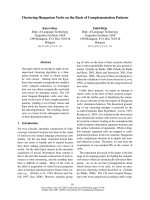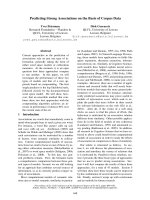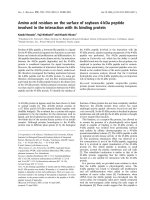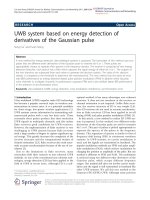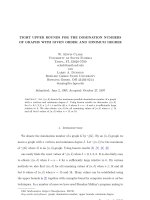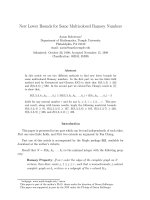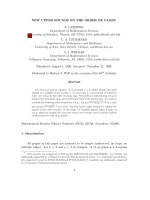Báo cáo toán học: "NEW UPPER BOUNDS ON THE ORDER OF CAGES1" pps
Bạn đang xem bản rút gọn của tài liệu. Xem và tải ngay bản đầy đủ của tài liệu tại đây (145.64 KB, 11 trang )
NEW UPPER BOUNDS ON THE ORDER OF CAGES
1
F. LAZEBNIK
Department of Mathematical Sciences
University of Delaware, Newark, DE 19716, USA;
V. A. USTIMENKO
Department of Mathematics and Mechanics
University of Kiev, Kiev 252127, Ukraine;
A. J. WOLDAR
Department of Mathematical Sciences
Villanova University, Villanova, PA 19085, USA;
Submitted: August 1, 1996; Accepted: November 21, 1996.
Dedicated to Herbert S. Wilf on the occasion of his 65
th
birthday
Abstract
Let k≥2 and g≥3 be integers. A (k,g)-graph is a k-regular graph with girth
(length of a smallest cycle) exactly g. A (k,g)-cage is a (k,g)-graph of minimum
order. Let v(k,g) be the order of a (k,g)-cage. The problem of determining v(k,g) is
unsolved for most pairs (k,g) and is extremely hard in the general case. It is easy to
establish the following lower bounds for v(k,g): v(k,g)≥
k(k−1)
(g−1)/2
−2
k−2
for g odd,
and v(k,g)≥
2(k−1)
g/2
−2
k−2
for g even. The best known upper bounds are roughly the
squares of the lower bounds. In this paper we establish general upper bounds on
v(k,g) which are roughly the 3/2 power of the lower bounds, and we provide explicit
constructions for such (k,g)-graphs.
Mathematical Reviews Subject Numbers: 05C35, 05C38. Secondary: 05D99.
1. Introduction
All graphs in this paper are assumed to be simple (undirected, no loops, no
multiple edges). Let k ≥ 2 and g ≥ 3 be integers. A (k, g)-graph is a k-regular
1
This research was supported by NSF grants DMS-9115473 and DMS-9622091. A.J. Woldar was
additionally supported by a Villanova University Faculty Research Grant. V.A. Ustimenko was addition-
ally supported in part by INTAS-93-2530 and INTAS-94-3420. F. Lazebnik was additionally supported
by a University of Delaware Research Award.
1
the electronic journal of combinatorics 4 (no. 2) (1997) , #R13 2
graph with girth (length of a smallest cycle) exactly g. A (k, g)-cage is a (k, g)-graph
of minimum order. The problem of determining the order v(k, g) of a (k, g)-cage is
unsolved for most pairs (k, g) and is extremely hard in the general case. By counting
the number of vertices in the breadth-first-search tree of a (k, g)-graph, one easily
establishes the following lower bounds for v(k, g):
v(k, g) ≥
k(k−1)
(g−1)/2
−2
k−2
for g odd,
2(k−1)
g/2
−2
k−2
for g even.
Graphs whose orders achieve these lower bounds are very special and possess many
remarkable properties. Though there is no complete agreement on terminology, they
are often referred to as “Moore graphs” when g is odd, and “regular generalized
polygons” when g is even. For references on cages, see Wong [23], Section 6.9 of
Brouwer, Cohen and Neumaier [6], Chapter 23 of Biggs [2], and Chapter 6 of Holton
and Sheehan [8]. For a survey of results on cubic cages (k = 3) with girth at most
20, see Royle [18].
Finding upper bounds for v(k, g) is a far more difficult affair; indeed, even
the fact that v(k, g) is finite is nontrivial to prove. This was settled by Sachs [19]
who showed by explicit construction that (k, g)-graphs of finite order exist. In the
same year, Erd˝os and Sachs [7] gave, without explicit construction, a much smaller
general upper bound on v(k, g). (As was pointed by Alon in [1, p. 1752], although
their proof does supply a polynomial time algorithm for constructing graphs which
provide the upper bound, their graphs are not really explicit in the sense that it is
not clear how to decide efficiently whether or not two prescribed vertices of such a
graph are adjacent.) Their result was later improved, though slightly, by Walther
[21], [22] and by Sauer [20]. The following upper bounds are due to Sauer [20]:
v(k, g) ≤
2(k − 1)
g−2
for g odd and k ≥ 4, and
4(k − 1)
g−3
for g even and k ≥ 4.
(1)
Note that these upper bounds are roughly the squares of the previously indicated
lower bounds.
In this paper we establish general upper bounds on v(k, g) which are roughly
the 3/2 power of the lower bounds, and we provide explicit constructions for such
(k, g)-graphs. The main results are described below.
2
the electronic journal of combinatorics 4 (no. 2) (1997) , #R13 3
Theorem A. Let k ≥ 2 and g ≥ 5 be integers, and let q denote the smallest odd
prime power for which k ≤ q. Then
v(k, g) ≤ 2kq
3
4
g−a
, (2)
where a = 4, 11/4, 7/2, 13/4 for g ≡ 0, 1, 2, 3 mod 4, respectively.
The upper bounds in (2) are better the ones provided in (1) for all k ≥ 5 and g ≥
5.
For k ≥ t ≥ 3 and q ≡ 1 mod t, (k, 2t)-graphs of orders at least as large as the
upper bound in (2) were constructed in [9] by F¨uredi, Seress, and the authors.
The fact that the orders of these constructions actually meet the upper bound in
(2) for q odd follows from [13]. The constructions we introduce in this paper are
independent of the relative magnitudes of k and g.
Constructions. For all k ≥ 3 and g ≥ 6, g even, we explicitly construct a (k, g)-
graph of order
g
1 + (k − 2)kq
g−5−
g−3
4
; (3)
for all k ≥ 3 and g ≥ 5, g odd, we explicitly construct a (k, g)-graph of order
(g + 1)
1 + (k − 2)kq
g−4−
g−2
4
. (4)
In either case, q is the smallest odd prime power for which k ≤ q.
Though the upper bounds on v(k, g) provided by these constructions are not
as good as the ones given in Theorem A, they are better than the bounds in (1)
for all k ≥ 7 and g ≥ 11 when g is odd, and g ≥ 8 when g is even. With some
additional restrictions on k and g these constructive upper bounds can be improved
still further.
By Chebyshev’s Theorem, for a fixed integer k ≥ 3 there is always a prime
between k and 2k − 2. For any > 0 and k ≥ k
0
(), this interval can be narrowed
to [k, k + k
3
5
+
], see [17, p. 131]. Thus the upper bounds from (2), (3), and (4) are
roughly the 3/2 power of the indicated lower bounds.
3
the electronic journal of combinatorics 4 (no. 2) (1997) , #R13 4
2. Preliminary Results and Proof of Theorem A
The possibility of improving the upper bounds in (1) for (k, g) ∈ A × B, where
both A and B are certain infinite subsets of positive integers, became apparent after
the discoveries of certain special infinite families of graphs which we describe below
(see F1, F2 and F3).
For a fixed integer k ≥ 3, let {G
i
}
i≥1
be a family of k-regular graphs of in-
creasing order v
i
. Let g
i
denote the girth of G
i
. The family {G
i
} is called a family
of graphs with large girth if
g
i
≥ γ log
k−1
(v
i
)
for some positive constant γ and all i ≥ 1. The lower bound for v(k, g) shows that
γ ≤ 2, but no infinite family has been found for which γ = 2.
F1. Margulis [16] and, independently, Lubotzky, Phillips and Sarnak [15] came up
with similar examples of graphs with γ ≥ 4/3 and arbitrary large valency (they
turned out to be so–called Ramanujan graphs). These are Cayley graphs of the
group PGL
2
(Z
q
) with respect to a set of p+1 generators, where p and q are distinct
primes, each congruent to 1 mod 4, with the Legendre symbol
p
q
= −1. Denoted
by X
p,q
, they are (p + 1)-regular bipartite graphs of order q(q
2
− 1). Margulis [16]
and, independently, Biggs and Boshier [3] showed that the asymptotic value of γ
for the graphs X
p,q
is exactly 4/3. Moreover, in both papers an explicit formula for
the girth g(X
p,q
) of X
p,q
was found. To state their results (formulae (5), below) we
first need the following definition.
Call an integer good if it is not of the form 4
α
(8β + 7) for any nonnegative
integers α, β. By a theorem of Legendre, good numbers are precisely those which
are representable as sums of three squares. Then
g(X
p,q
) =
22 log
p
q if p
2 log
p
q
− q
2
is good,
22 log
p
q + log
p
2 otherwise.
(5)
F2. In [10], Lazebnik and Ustimenko constructed the family of graphs D(n, q),
n ≥ 2, q a prime power, for which γ ≥ log
q
(q − 1). Graphs D(n, q) are q-regular of
order 2q
n
and girth at least n + 4 (respectively, n + 5) for n even (respectively, n
odd). These are defined as follows.
Let q be a prime power, and let P and L be two copies of the countably infinite
dimensional vector space over GF (q). In order to distinguish between vectors from
4
the electronic journal of combinatorics 4 (no. 2) (1997) , #R13 5
P and L we use parentheses and brackets: x ∈ P will be written as (x), and y ∈ L
as [y]. Adopting the notation for coordinates of points and lines introduced in [10],
namely,
(p) = (p
1
, p
11
, p
12
, p
21
, p
22
, p
22
, p
23
, . . . , p
ii
, p
ii
, p
i,i+1
, p
i+1,i
, . . .),
[l] = [l
1
, l
11
, l
12
, l
21
, l
22
, l
22
, l
23
, . . . , l
ii
, l
ii
, l
i,i+1
, l
i+1,i
, . . .],
we define an infinite bipartite graph D(q) with the vertex set P ∪ L as follows. We
say (p) is adjacent to [l] if the following relations on their coordinates hold:
l
11
− p
11
= l
1
p
1
l
12
− p
12
= l
11
p
1
l
21
− p
21
= l
1
p
11
l
ii
− p
ii
= l
1
p
i−1,i
l
ii
− p
ii
= l
i,i−1
p
1
l
i,i+1
− p
i,i+1
= l
ii
p
1
l
i+1,i
− p
i+1,i
= l
1
p
ii
(6)
(The last four relations are defined for all i ≥ 2.) For each positive integer n ≥ 2
we obtain a finite bipartite graph D(n, q) as follows. First, P
n
and L
n
are obtained
from P and L, respectively, by simply projecting each vector onto its n initial
coordinates. Let the set of vertices of D(n, q) be P
n
∪ L
n
. Adjacency in D(n, q) is
now defined in terms of the first n−1 relations of (6), and no others. (Note that
these relations involve only the first n coordinates of vectors from P ∪ L, so apply
unambiguously to vectors from P
n
∪ L
n
.)
In [12], Lazebnik, Ustimenko and Woldar showed that the graphs D(n, q) are
disconnected for n ≥ 6 and that their connected components CD(n, q) (all isomor-
phic) have order at most 2q
n−
n+2
4
+1
. As CD(n, q) and D(n, q) have the same
girth, it follows that the graphs CD(n, q) form a family for which γ ≥
4
3
log
q
(q − 1).
With few exceptions, these graphs provide the best known asymptotic lower bound
for the greatest number of edges in graphs of their order and girth. Later, in [13],
the authors proved that for q odd, the order of CD(n, q) is exactly 2q
n−
n+2
4
+1
.
Combining this with a result from [9] on the existence of a girth cycle of length
n + 5 in D(n, q) for all odd n and infinitely many q , we get that the corresponding
subfamily of graphs CD(n, q) satisfies γ =
4
3
log
q
(q − 1).
An important property of graphs D(n, q) and CD(n, q) is that they contain a
special type of induced subgraph. These were introduced by the authors in [11] and
5
the electronic journal of combinatorics 4 (no. 2) (1997) , #R13 6
can be described as follows. Let R, S ⊆ GF (q), where |R| = r ≥ 1 and |S| = s ≥ 1,
and let
P
R
= {(p) ∈ P
n
|p
1
∈ R}
L
S
= {[l] ∈ L
n
|l
1
∈ S}.
We define D(n, q, R, S) to be the subgraph of D(n, q) induced on P
R
∪ L
S
. For
fixed (p) ∈ P
R
and arbitrary x ∈ S, there exists a unique neighbor [l] of (p) in
D(n, q, R , S) with first coordinate l
1
equal to x. Since there are precisely s choices
for x, the adjacency relations (6) imply that the degree of (p) in D (n, q, R, S) is
s. Similarly, for any [l] ∈ L
S
the degree of [l] in D(n, q, R, S) is r. Therefore
D(n, q, R , S) is an induced subgraph of D(n, q) with bi-degree s, r (every vertex
from P
R
has degree s and every vertex from L
S
has degree r). Analogously, we
denote by CD(n, q, R, S) the induced subgraph of CD(n, q) obtained by performing
this procedure on CD(n, q). As with D(n, q, R, S), the graph CD(n, q, R, S) has
bi-degree s, r.
F3. In [9] F¨uredi and Seress, together with the authors, showed that for all r, s, t ≥
2, there exists a bipartite graph of girth 2t and bi-degree r, s. They also showed that
for all r, s ≥ t ≥ 3, there exists a bipartite graph with bi-degree r, s and girth 2t of
order (r + s)q
2t−6
, where q ≥ r, s is the smallest prime power of the form 1 + mt
for some integer m ≥ 1. This graph was constructed as D(2t − 5, q, R, S) where R
and S were chosen in a special way. As follows from [13], CD(2t − 5, q, R, S) is an
(r, 2t)-graph of order 2rq
2t−5−
2t−3
4
when r = s ≥ t ≥ 3.
Each of the three families described in F1-F3 can be used to improve the upper
bound in (1) for (k, g) ∈ A × B, where both A and B are infinite subsets of positive
integers. The authors expended considerable energy attempting to extend these
improvements to a set A× B where A and B are not just infinite subsets of positive
integers but have finite complements, e.g. A = {a : a ≥ a
0
} and B = {b : b ≥ b
0
},
for some positive integers a
0
, b
0
. We tried to do this constructively by considering
special subgraphs of X
p,q
and CD(n, q).
A natural way to find a k-regular subgraph in the Cayley graph X
p,q
is to
restrict the set of p + 1 generators to a symmetric k-element subset. The difficulty
is to do this in such a way that the girth of the subgraph equals a prescribed
even integer g. Formulae (5) are not of much help here. Another drawback to
this approach is that the subgraph is not necessarily induced, which decreases its
chances of having a small number of vertices in comparison to its valency and girth.
The situation is better with graphs CD(n, q). Indeed, the subgraphs
CD(n, q, R, R), |R| = k ≤ q, are not only k-regular but induced. Though we seem to
6
the electronic journal of combinatorics 4 (no. 2) (1997) , #R13 7
have some additional control on measuring the girth of these subgraphs, an exact
determination is very difficult. Even in those cases where we know g(CD(n, q))
(equivalently, g(D(n, q))) explicitly, we have not yet found a way to either preserve
this girth, or trace its change, when passing to induced subgraphs with given but
arbitrary valency k. All that we know with certainty is the obvious fact that these
subgraphs have girth at least n + 5 for n odd and n + 4 for n even, as the same
property holds for the graphs CD(n, q).
Our prospects of solving this problem looked rather grim until a few months
ago when new results came in a rather unexpected way. First, we discovered a
simple way to construct families of (k, g)-graphs from those of k-regular graphs of
girth at least g. Applying this construction to the graphs CD(2
g+1
2
− 5, q), we
obtained the upper bounds given in (3) and (4). Soon after, we realized that we had
overlooked a beautiful result of Erd˝os and Sachs, which asserts that the orders of k-
regular graphs of girth at least g provide upper bounds on the orders of (k, g)-cages.
Namely,
Theorem 2.1 [7] Let G be a k-regular graph of girth at least g having the least
number of vertices. Then the girth of G is g and the diameter of G is at most g.
A proof of this theorem can be found in [14, pp. 66, 384, 385], see also the ref-
erences therein. Applying it to the k-regular subgraphs CD(n, q, R, R) of CD(n, q),
where n = 2
g+1
2
− 5 and |R| = k ≤ q, one immediately obtains the general non-
constructive upper bounds given in (2) which are better than those given in (1).
The modulo 4 classification is trivial; thus Theorem A is proven.
3. Constructions
As we mentioned in the Introduction, for k ≥ t ≥ 3 and q the smallest prime
power for which q ≥ k and q ≡ 1 mod t, (k, 2t)-graphs whose orders are at least as
large as the upper bound in (2) were constructed by F¨uredi, Seress and the authors,
see [9]. The fact that the orders of these constructions actually meet the upper
bound in (2) for q odd follows from [13]. Therefore the constructions we present
below are interesting mainly for k < g/2. Before proceeding, we mention that in
every case the graphs we construct can be viewed, roughly, as being formed by
appending an appropriate number of high girth graphs to a “central” g-cycle.
Case 1: g even. Let k ≥ 3 be an integer, g = 2s ≥ 4 an even integer, and
C = v
1
v
2
. . . v
2s
v
1
a cycle of order g. Let {H
ij
} be an arbitrary family of k-regular
7
the electronic journal of combinatorics 4 (no. 2) (1997) , #R13 8
graphs, each of order v and girth at least g, 1 ≤ i ≤ s, 1 ≤ j ≤ k − 2. In each H
ij
choose, arbitrarily, a “distinguished” edge and denote it by a
ij
b
ij
. Now, denote by
H
∗
ij
the graph obtained from H
ij
by deleting edge a
ij
b
ij
. Finally, form the graph
H by adjoining the graphs H
∗
ij
to the cycle C in the following manner: For each
1 ≤ i ≤ s, 1 ≤ j ≤ k − 2, adjoin vertex a
ij
(respectively, b
ij
) of graph H
∗
ij
to vertex
v
2i−1
(respectively, v
2i
) of C. It is trivial to see that H is a k-regular graph of order
g + s(k − 2)v and that the girth of H is at most g.
Let us show that g(H) = g. Let K be a cycle in H of order less than g.
Then K must contain at least one pair of edges of the form a
i
0
j
0
v
2i
0
−1
, b
i
0
j
0
v
2i
0
, as
otherwise K would be a cycle in either C or H
ij
for some i,j. But now the portion
of K which lies in H
∗
i
0
j
0
, together with the edge a
i
0
j
0
b
i
0
j
0
, forms a cycle in H
i
0
j
0
of
order less than g.
Now, taking each H
ij
to be the k-regular subgraph CD(g−5, q, R, R) of CD(g−
5, q), where q is the smallest odd prime power for which q ≥ k = |R|, we obtain the
order of H as appears in (3).
Case 2: g odd. Let k ≥ 3 be an integer, g = 2s − 1 ≥ 3 an odd integer, and
C = v
1
v
2
. . . v
2s−1
v
1
a cycle of order g. Adjoin a new vertex v
2s
to v
2s−1
but to no
other vertex of C.
With {H
ij
}, a
ij
b
ij
, and H
∗
ij
(1 ≤ i ≤ s, 1 ≤ j ≤ k − 2) defined exactly as in
Case 1, we form H as follows: For each 1 ≤ i ≤ s − 1, 1 ≤ j ≤ k − 2, adjoin vertex
a
ij
(respectively, b
ij
) of graph H
∗
ij
to vertex v
2i−1
(respectively, v
2i
) of C. Next
for each 1 ≤ j ≤ k − 3, adjoin vertex a
sj
(respectively, b
sj
) of graph H
∗
sj
to vertex
v
2s−1
of C (respectively, vertex v
2s
). Finally, adjoin both vertices a
s,k−2
and b
s,k−2
of H
∗
s,k−2
to vertex v
2s
.
It is routine to check that H is k-regular of order g + 1 + s(k − 2)v, and
that the girth of H is at most g. One uses an argument similar to that given in
Case 1 to establish that g(H) = g. Taking each H
ij
to be the k-regular subgraph
CD(g −4, q, R, R) of CD (g −4, q), where q is the smallest odd prime power for which
q ≥ k = |R|, we obtain the order of H as appears in (4).
Remark. It is easy to see that the diameter of a k-regular graph of order v is
at least log
k−1
v and that the random k-regular graph has diameter close to this
lower bound, see [5, Ch. X3]. Though several explicit constructions of families of k-
regular graphs with diameters close to log
k−1
v are known [5, Ch. X1] these all have
small girth. The problem of constructing infinite families of graphs of large girth
8
the electronic journal of combinatorics 4 (no. 2) (1997) , #R13 9
and small diameter (i.e. with diameter at most c log
k−1
v, c ≥ 1 a constant) is far
from trivial. For the Ramanujan graphs described in F1, diameter is known to be
at most 2 log
k−1
v + 2, and the proof of this fact is not simple. The upper bound on
the girth of graphs CD(n, q), together with the statement in Theorem 2.1 regarding
diameter of cages, implies that for every k ≥ 3 there exists a family of graphs of
large girth {G
i
}
i≥1
such that g(G
i
) ≥
4
3
log
k−1
v
i
and diam(G
i
) ≤
4
3
log
k−1
v
i
. We
conjecture that the diameter of graphs CD(n, q) is within an additive constant of
this bound. More precisely,
Conjecture. There exists a positive constant C such that for all integers n ≥ 2
and all prime powers q,
diam (CD(n, q)) ≤ (log
q−1
q)n + C .
9
the electronic journal of combinatorics 4 (no. 2) (1997) , #R13 10
References
1. N. Alon, Tools from Higher Algebra, in: Handbook of Combinatorics, Volume
II (edit. R. L. Graham, M. Gr¨otschel, L. Lov´asz), MIT Press, North-Holland,
New York, 1995.
2. N. L. Biggs, Algebraic Graph Theory (2nd ed.), Cambridge University Press,
1993.
3. N. L. Biggs and A. G. Boshier, Note on the girth of Ramanujan graphs, Journal
of Combinatorial Theory Series B, vol. 49 , 190-194 (1990).
4. B. Bollob´as, Extremal Graph Theory, Academic Press, London, 1978.
5. B. Bollob´as, Random Graphs, Academic Press, London, 1985.
6. A. E. Brouwer, A. M. Cohen, A. Neumaier, Distance-Regular Graphs, Springer-
Verlag, Heidelberg – New York, 1989.
7. P. Erd˝os and H. Sachs, Regul¨are Graphen gegebener Taillenweite mit mini-
maler Knotenzahl, Wiss. Z. Univ. Halle Martin Luther Univ. Halle–Wittenberg
Math.–Natur.Reine 12 (1963), 251-257.
8. D. A. Holton, J. Sheehan, The Petersen Graph, Australian Mathematical So-
ciety, Lecture Notes 7, Cambridge University Press, 1993.
9. Z. F¨uredi, F. Lazebnik,
´
A. Seress, V. A. Ustimenko, A. J. Woldar, Graphs of
prescribed girth and bi-degree, Journal of Combinatorial Theory Ser. B 64
(2) (1995), 228-239.
10. F. Lazebnik, V. A. Ustimenko, Explicit construction of graphs with arbitrary
large girth and of large size, Discrete Applied Mathematics 60 (1995), 275-284.
11. F. Lazebnik, V. A. Ustimenko, A. J. Woldar, New constructions of bipartite
graphs on m, n vertices, with many edges, and without small cycles, Journal of
Combinatorial Theory Ser. B 61 (1) (1994), 111-117.
12. F. Lazebnik, V. A. Ustimenko, A. J. Woldar, A new series of dense graphs of
high girth, Bulletin of the AMS 32 (1) (1995), 73-79.
13. F. Lazebnik, V. A. Ustimenko, A. J. Woldar, A characterization of the compo-
nents of the graphs D(k, q), Discrete Mathematics 157 (1996) 271–283.
14. L. Lov´asz, Combinatorial Problems and Exercises, North-Holland, Amsterdam,
1979.
10
the electronic journal of combinatorics 4 (no. 2) (1997) , #R13 11
15. A. Lubotzky, R. Phillips, R. Sarnak, Ramanujan graphs, Combinatorica 8 (3)
(1988), 261-277.
16. G. A. Margulis, Explicit group-theoretical construction of combinatorial
schemes and their application to the design of expanders and concentrators,
Journal of Problems of Information Transmission (1988), 39-46.
17. H. L. Montgomery, Topics in Multiplicative Number Theory, Lecture Notes in
Mathematics 227, Springer Verlag, New York, 1971.
18. G. Royle, Cubic cages, />19. H. Sachs, Regular graphs with given girth and restricted circuits, J. London
Math. Society 38 (1963), 423-429.
20. N. Sauer, Extremaleigenschaften regul¨arer Graphen gegebener Taillenweite, I
and II, Sitzungsberichte
¨
Osterreich. Acad. Wiss. Math. Natur. Kl., S-B II, 176
(1967), 9-25; 176 (1967), 27-43.
21. H. Walther, Eigenschaften von regul¨aren Graphen gegebener Taillenweite und
minimaler Knotenzahl, Wiss. Z. Ilmenau 11 (1965), 167-168.
22. H. Walther,
¨
Uber regul¨are Graphen gegebener Taillenweite und minimaler
Knotenzahl, Wiss. Z. Techn. Hochsch. Ilmenau 11 (1965), 93-96.
23. P K. Wong, Cages – A Survey, Journal of Graph Theory Vol. 6 (1982), 1-22.
11
